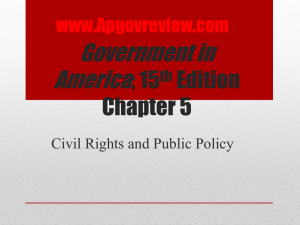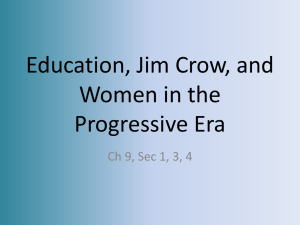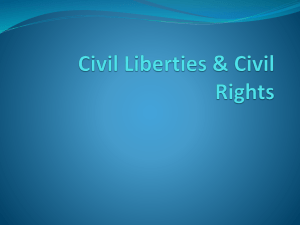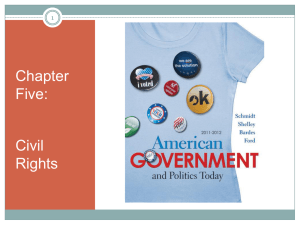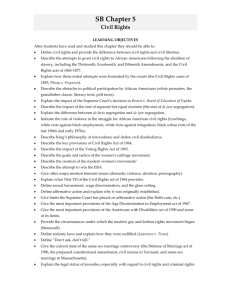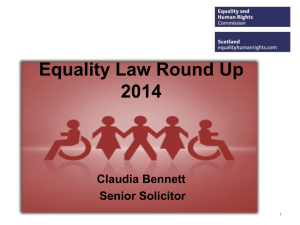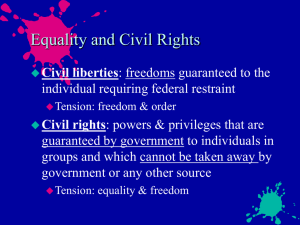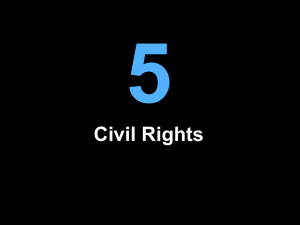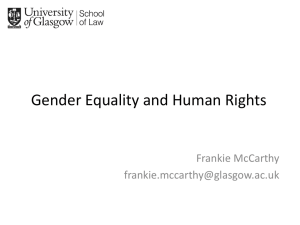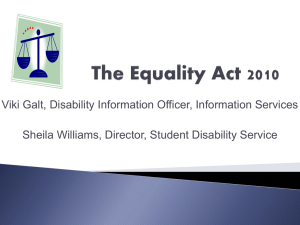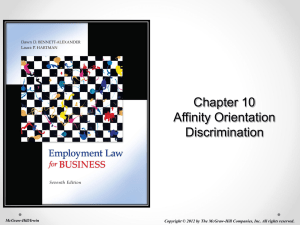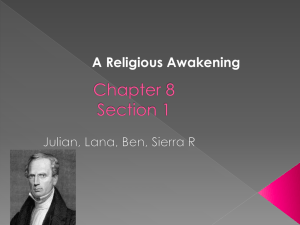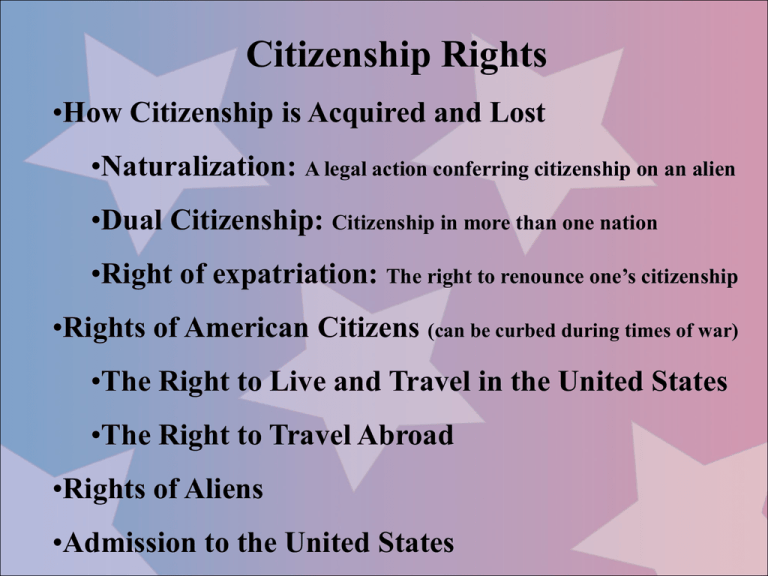
Citizenship Rights
•How Citizenship is Acquired and Lost
•Naturalization: A legal action conferring citizenship on an alien
•Dual Citizenship: Citizenship in more than one nation
•Right of expatriation: The right to renounce one’s citizenship
•Rights of American Citizens (can be curbed during times of war)
•The Right to Live and Travel in the United States
•The Right to Travel Abroad
•Rights of Aliens
•Admission to the United States
Requirements for
Naturalization
Equal Rights Under the Law
• The Constitution does not make any reference to
“equality”
• But the framers did create a government designed to
protect natural rights
Equality and Equal Rights
• Most agree that everyone should have equality of
opportunity
• Some also focus attention on equality between groups
– Affirmative action
• Questions regarding equality of results
Civil Rights: Introduction
• Refer to those things that the government must do to
provide equal protection and freedom from
discrimination for all citizens.
• Traditionally, thought of as rooted in the Fourteenth
Amendment to the Constitution.
• Early attempts at true protection were unsuccessful
because the Supreme Court believed that it was not
within its purview to stop non-governmental
discrimination.
Dred Scott, Reconstruction,
and “Jim Crow”
This is a portrait of Dred Scott
(1795–1858), an American slave who
was born in Virginia and who later
moved with his owner to Illinois,
where slavery was illegal. He was
the nominal plaintiff in a test case
that sought to obtain his freedom on
the ground that he lived in the free
state of Illinois. Although the
Supreme Court ruled against him,
he was soon emancipated and
became a hotel porter in St. Louis.
Slavery in the United States
• Ending servitude
– The Thirteenth Amendment (1865) prohibits
slavery within the United States.
– The Fourteenth Amendment (1868) established
that all persons born in the United States are
citizens and no state shall deprive citizens of their
rights under the Constitution.
– The Fifteenth Amendment (1870) established the
right of citizens to vote.
Early Civil Rights Legislation
During Reconstruction (late 1860s-1870s), Congress passed civil
rights laws, but, the Supreme Court struck down many of these laws.
• The Civil Rights Acts of 1865 to 1875
– Aimed at the Southern states.
– Attempted to prevent states from passing laws that would
circumvent the amendments
By 1877, Reconstruction was ended, and northern political leaders
abandoned African Americans to their fate at the hands of their former white
masters.
• The Civil Rights Cases (1883)
– Invalidated much of the civil rights legislation in the Civil Rights
cases.
Beginning with WWI, African Americans began to migrate northward.
Major Civil Rights Legislation
•
•
•
•
•
•
•
•
•
•
Civil Rights Act, 1957
Civil Rights Act, 1964
Voting Rights Act, 1965
Age Discrimination in Employment Act, 1967
Fair Housing Act, 1968
Title IX, Education Amendment of 1972
Rehabilitation Act, 1973
Fair Housing Act Amendments, 1988
Americans with Disabilities Act, 1990
Civil Rights Act, 1991
Challenges to Civil Rights Legislation
•Segregation and White Supremacy
• Plessy v. Ferguson
– Separate-but-Equal Doctrine
• Voting Barriers
– White primary, the grandfather clause, poll taxes,
literacy tests
• Extralegal Methods of Enforcing White Supremacy
•Slow Government Response
The Quest for Equal Justice
•A Turning Point
•Martin Luther King, Jr., Rosa Parks,
and the Montgomery, AL, Bus Boycott
You may well ask, ‘Why direct action? Why sitins, marches, and so forth? Isn’t negotiation a
better path?’ You are quite right in calling for
negotiations. Indeed, this is the very purpose of
direct action. Nonviolent direct action seeks to
create such a crisis and foster such a tension that
a community which has constantly refused to
negotiate is forced to confront the issue.
-Dr. Martin Luther King
The End of the Separate-but-Equal Doctrine
• Brown v. Board of Education of Topeka
– Overturned Plessy v. Ferguson
– “With All Deliberate Speed.”
• Court-Ordered Busing
• The Resurgence of
Minority Schools
• The Civil Rights Act of
1964
–
–
–
–
Voter registration
Public accommodations
Public schools
Employment
The power to regulate interstate commerce allowed
Congress to forbid discrimination like this in places of
public accommodation in the 1964 Civil Rights Act.
The Quest for Equal Justice
•Riots and Reaction
•Watts, CA 1965
•Detroit 1967
•Vietnam War and Watergate
diverted attention from civil rights
•Little governmental attention since
then
Women’s Struggle for Equal Rights
• Early Women’s Political Movements
– Activism for women’s rights
began with the Seneca Falls
convention in 1848.
• Fifteenth Amendment did
not bar denial of the vote
on the grounds of gender
• Women had to fight for
universal suffrage
• Women’s Suffrage
Associations
• Nineteenth Amendment (1920)
Women’s Struggle for Equal Rights
Women Suffrage in the U.S. Compared to other countries
2015
2015
Saudi
Arabia
The Modern
Women’s Movement
“Four-fifths of a penny for your thoughts”
The Modern Women’s Movement
• Wage Discrimination
– Recent figures show a woman earns
80 cents for every dollar made by a man.
– The Equal Pay Act of 1963
– The Glass Ceiling
• The Equal Rights Amendment
• Additional Women’s Issues
– Domestic violence
– Abortion rights
– Pornography (divided the movement rather than united it).
• Discrimination in the Courts
• Expanding Women’s Political Activities
– Women in Congress, the Executive, & Judicial Branches
– Continuing Disproportionate Leadership
President Kennedy signed
the Equal Pay Act of 1963
to provide equal pay for
women.
How Many Women
Work, 2006
The Quest for Equal Justice
Hispanics have suffered discrimination
in housing, employment, public
accommodations, and education, and have
faced harsh treatment from police and
other government officials
•Repatriation
•Zoot Suit Riots
•High school walk outs
•May Day Riot in Los Angeles
•Racial Profiling with Immigration
raids
•English Only laws
•Dream Act
Cesar Chavez founded the National
Farm Workers Association
The Quest for Equal Justice
•Chinese Americans
•Japanese Americans
•Other Asian Americans
•Native Americans
• Reservations
• History of discrimination
– Trail of Tears
– Urban Relocation Program
• Activist groups
– American Indian Movement (AIM)
– ACLU
Dilos Lonewolf
became Tom Torlino,
during his
transformation at a
boarding school
in Carlisle, PA.
Indians were shorn of
their hair and clothes
and trained to adopt
white ways.
American Indians feel renewed cultural pride in ancient traditions but also
the lure of modern technology.
Percent of Bachelor’s Degrees Awarded by Gender
Equal Protection of the Laws: What
Does It Mean?
Constitutional Classification and Tests
• Rational Basis Test
• Quasi-Suspect Classifications and
Heightened Scrutiny
• Suspect Classifications and Strict Scrutiny
Covers
• Race, Gender, Fundamental Rights
Does Not Cover
• Poverty, Age, Sexual Orientation
Proving Discrimination
The Supreme Court uses which tests to
distinguish between constitutional and
unconstitutional classifications
a. the rational basis test
b. the strict scrutiny test
c. the heighten scrutiny test
d. all of the above
Which of the following is not suspect
classifications of the constitution?
a. sex
b. race
c. national origin
d. poverty
One of the following situations is outside
government jurisdiction.
a. a restaurant bars men without jacket and tie
b. a hotel refuses to register a rock – and – roll
star
c. a realtor refuses to sell property to an
extended Vietnamese family
d. a theater refuses to seat a group with long
hair and blue jeans
Voting Rights
•Protecting Voting Rights
•The Voting Rights Act of 1965
• Authorizes the
Department of Justice to
appoint federal examiners
to register voters in areas
with a history of
discrimination.
Devices used to prevent African Americans from voting
Poll Tax
White Primary
Literacy Tests
Racial
Gerrymandering
Voting Rights
Act of 1965
Increases Black
Voter
Registration in
Seven Southern
States
Which of the following is correct about
Voting
a. The Voting Rights Act of 1965 has been
effective.
b. The Voting Rights Act of 1965, as amended,
set aside literacy tests throughout the country.
c. Most suffrage requirements, inside the U.S.
constitutional framework, are fixed by the
states.
d. All of the above.
Education Rights
•The End of “Separate but Equal”: Brown v.
Board of Education
•From Segregation to Desegregation – but Not
Yet Integration
De Jure
Segregation
De Facto
Segregation
Segregation and
discrimination
mandated by state and
local laws
Segregation and
discrimination resulting
from economic or social
conditions or personal
choice
Rights of Association,
Accommodations, Jobs, and Homes
•Association
•Accommodations
•Title II: Places of Public
Accommodation
•Title VII: Employment
discrimination
•The Fair Housing Act and
Amendments
•The Civil Rights Act of 1968 and
Other Housing Reform Legislation
The Affirmative Action Controversy
• University of California v. Bakke (1978) was one of the
earliest challenges to affirmative action in the
university
• After Bakke: Refinements and Uncertainty
• Richmond v. Croson (1989)
• California’s Proposition 209
and Other Plans
Reaffirming the
Importance of Diversity
•Gratz v. Bollinger (2003)
•Grutter v. Bollinger (2003)
The 1896 Supreme Court ruling that
approved of “separate but equal” was
a. Brown v. Board of Education
b. Roe v. Wade
c. Plessy v. Ferguson
d. Shaw v. Reno
Segregation required by laws is called
a. De jure segregation
b. De facto segregation
c. Spatial segregation
d. Social segregation
Which of these cases marked the end of the
“separate but equal” interpretation of the
Constitution?
a. Brown v. Board of Education
b. Bakke v. California Regents
c. Plessy v. Ferguson
d. Weber v. Kaiser
Special Protection for Older Americans
• The Age Discrimination in Employment Act of 1967
– Prohibits discrimination by age in all but a limited
number of occupations where age is considered relevant
to the job.
• Mandatory retirement has progressively been made
illegal by laws passed in 1978 and 1986.
Securing Rights for Persons with Disabilities
• The Americans with Disabilities Act of 1990
– Prohibits job discrimination against individuals with
physical or mental disabilities.
– Requires physical access to public buildings and public
services.
Securing Rights for Persons with Disabilities
• Limiting the ADA - No longer covered are:
– persons who wear eyeglasses
– carpal tunnel syndrome, a repetitive stress injury
The Rights and Status of Gay Males & Lesbians
• Growth in the Gay Male
and Lesbian Rights
Movement
• State and Local Laws
Targeting Gay Males
and Lesbians
The Rights and Status of Gay Males & Lesbians
(continue)
• The Gay Community and Politics
– Gay activists now play a role in both major parties.
Eleven openly gay men or lesbians sit in the House.
• Gay Men and Lesbians in the Military
• Same-Sex Marriages
• Child Custody and Adoption
The Rights and Status of Juveniles
• The presumption that children are protected by parents
• Voting Rights and the Young
• Rights of Children in Civil and Criminal Proceedings
The Rights and Status of Juveniles
(continue)
• Civil Rights of Juveniles
– Child custody issues
• Criminal Rights of Juveniles
• Dealing with Juvenile Crime
– Minors tried as adults
– Parents held responsible
A person cannot become a citizen if he
or she is ___.
a. 16-years old
b. Lawfully admitted to the state for at least
five years
c. Found to have good moral character
d. Opposed to totalitarianism
Which of the following is NOT covered
by the Civil Rights Act?
a.
b.
c.
d.
Equality in accommodations
Equality in employment
Equality in housing
All of the above


